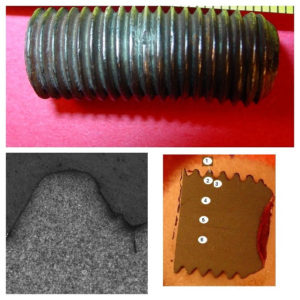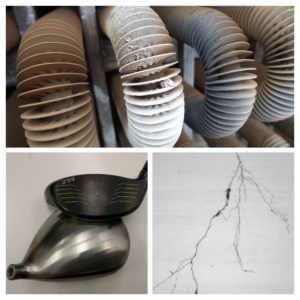Metallurgical Evaluation
In metallurgical failure analysis, a macroscopic visual examination of the fracture surface and external surfaces of the part begins the investigation and will be followed by microscopic examinations. An optical stereo microscope examination at magnifications of 50X or less will help to reveal fracture surface details, confirm fracture initiation locations and mode of failure, and reveal possible evidence of surface damage at the locations of fatigue crack initiation. There are differences observed in fatigue fracture surface appearances caused by the magnitude of the applied stress and the remaining cross sectional area when the fracture passes through each area. The main differences are observed by macroscopic visual fractography. Fatigue fracture surfaces typically show two distinct regions: the fatigue crack initiation and propagation region and the final overload region. In the final overload region, the presence of slanted 45 degree shear zones and their elongated fibrous dimple structure, or brittle cleavage features are indicative of rapid loading conditions.
 Structures, parts and materials fail, despite your best efforts. You need answers quickly to resolve operational problems and product defects to avoid unacceptable corrosion risks and catastrophic failures.We are allied with customers in the water and materials related industries and we service a comprehensive range of industries, including commercial building industries.Core asset failure can have far reaching consequences, which impact reputation, scheduling, and the bottom line.
Structures, parts and materials fail, despite your best efforts. You need answers quickly to resolve operational problems and product defects to avoid unacceptable corrosion risks and catastrophic failures.We are allied with customers in the water and materials related industries and we service a comprehensive range of industries, including commercial building industries.Core asset failure can have far reaching consequences, which impact reputation, scheduling, and the bottom line.
Failure analysis is the process of collecting and analyzing data to determine the cause of a failure, often with the goal of determining corrective actions or liability. It is an important discipline in many branches of manufacturing industry, such as the electronics industry, where it is a vital tool used in the development of new products and for the improvement of existing products. The failure analysis process relies on collecting failed components for subsequent examination of the cause or causes of failure using a wide array of methods, especially microscopy and spectroscopy. The NDT and non-destructive testing methods are valuable because the failed products are unaffected by analysis, so inspection sometimes starts using these methods.
We undertake failure analysis with networks of PE’s and NACE Certified Corrosion/Materials Selection/Design qualified metallurgists, chemical engineers, technologists and scientists who are some of the most experienced in their field. Using an extensive range of proven techniques and applications, we provide analysis of and insight for solving your asset failures, from pipeline failure assessment to commercial building corrosion risk analysis; evidence analysis to material characterization; and finally forensic engineering and litigation support.
Metallurgical Failure Analysis and Root Cause Investigation-Our Approach
 Once it has been determined that a failure has indeed occurred, the point of origin must be found, and a determination must be made as to whether the failure occurred as a result of design, method of manufacturing, service history and conditions, soil/water chemistry excursions, or from a deficiency in the material. When the point of origin is located, the investigation may proceed to a study of how the failure occurred, possible causes or factors in the failure, and possible means of preventative measures.
Once it has been determined that a failure has indeed occurred, the point of origin must be found, and a determination must be made as to whether the failure occurred as a result of design, method of manufacturing, service history and conditions, soil/water chemistry excursions, or from a deficiency in the material. When the point of origin is located, the investigation may proceed to a study of how the failure occurred, possible causes or factors in the failure, and possible means of preventative measures.
Why a failure occurs is an important question in the method of evaluation. This question can be approached by breaking down the failure into “mode of failure” and “cause of failure.” Mode of failure is the process by which the failure occurred. Cause of failure is that which can be fixed or changed to prevent future failures. Each question provides important clues to the investigation, and although priorities may be quite different, each question must be addressed and resolved to determine why a failure may have occurred.
Several important factors often associated with component failures are overloading conditions, vibrations, corrosive environments, deficiency in design, fabrication, operating conditions, unsuitable materials selection, and expended useful life. Our failure analysis procedure, or methodology for evaluation, will be provided in a step-by-step approach. This includes justification for conducting a failure analysis investigation, developing a logical plan for the investigation to follow, collection of background information, sample removal techniques, on-site inspection, laboratory testing and analysis, and the formulation of a final report based on relevant data, analysis, and recommendations.
We undertake failure analysis with networks of qualified metallurgists, chemical engineers, technologists and scientists who are some of the most experienced in their field. Using an extensive range of proven techniques and applications, we provide analysis of and insight for solving your asset failures, from pipeline failure assessment to commercial building corrosion risk analysis; evidence analysis to material characterization; and finally forensic engineering and litigation.
Your input is vital for our failure analysis root cause determination. By giving us a detailed description of the failure, you can be sure that all aspects of the failure investigation will be considered promptly. We’ll send you a proposal for your work/project, including methods, testing, specific recommendation and costs.
